#Karahan Tepe
Text

Archaeologists Discover 11,000-Year-Old Statue Clutching His Genitals in Turkey
Archaeologists in Turkey have unearthed a nearly 11,000-year-old statue that may depict a giant man clutching his penis, along with a life-size wild boar statue. The two statues come from the neighboring sites of Gobekli Tepe and Karahan Tepe, which are among the oldest temple sites in the world.
The wild boar statue, which is carved from limestone, was found at Gobekli Tepe and dates to between 8700 B.C. and 8200 B.C. It measures 4.4 feet (1.4 meters) long and 2.3 feet (0.7 m) high, the German Archaeological Institute said in a statement. Archaeologists detected red, black and white pigments on its surface, indicating that the sculpture was once painted. Archaeologists unearthed the large sculpture of the manat the site of Karahan Tepe, about 22 miles (35 kilometers) from Gobekli Tepe. It depicts a 7.5-foot-tall (2.3 m) man, according to a translated statement from Turkey's ministry of culture and tourism. The person's ribs, spines and shoulders are particularly pronounced, and the person may actually be depicted as being dead, the statement said.

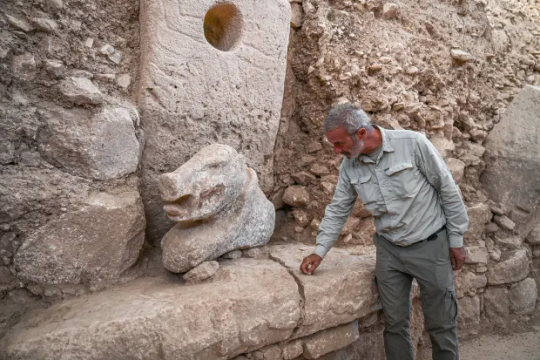
These discoveries, "represent the latest spectacular finds from these sites which are transforming our understanding of pre-agricultural communities," Benjamin Arbuckle, an anthropology professor at the University of North Carolina at Chapel Hill who was not involved with the excavations, said in an email.
Researchers also found a small sculpture of a vulture nearby at Karahan Tepe. While archaeologists didn't say how old the newfound statues at, Karahan Tepe are, the site is around 11,000 years old and contains other sculptures and buildings.
The purpose of the recently found sculptures is unclear. "The Karahan Tepe finds strike me as the most interesting," Ted Banning, an anthropology professor at the University of Toronto who is not involved with the research, said in an email. "Any interpretation of the statue is conjectural at this point," Banning said but suggested it was likely that the person shown is dead. It may represent "an important ancestor associated with the building in which it was found."
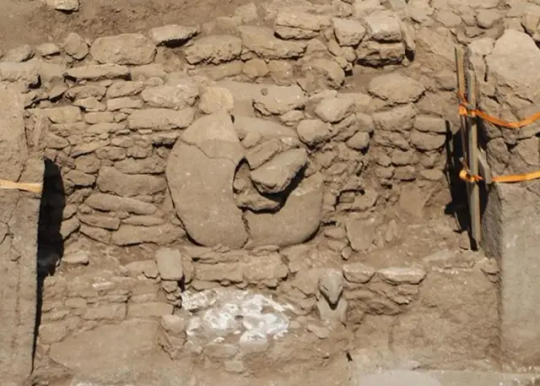
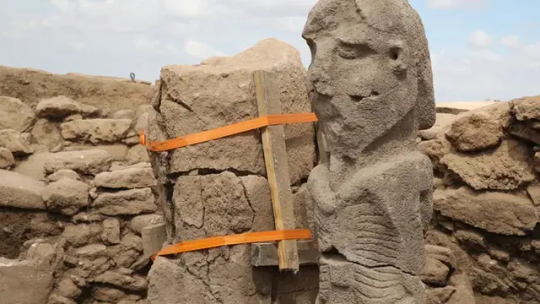
The figure's pose may give a further clue about its purpose. "The fact that the figure is clutching its penis is also consistent with this interpretation by potentially symbolizing that this person was the progenitor of a social group, such as a lineage or clan, associated with the building," Banning said.
Banning thinks that structures at Karahan Tepe and Gobekli Tepe may have been used as houses rather than temples, "in which case it makes a lot of sense that each would have its own lineage ancestor," Banning said.
It's not surprising that the wild boar sculpture has pigments, he added. "I think it's plausible that much or even most of the sculpture at these sites was originally painted", Banning said, noting that paint doesn't preserve well in the archaeological record.
By Owen Jarus.
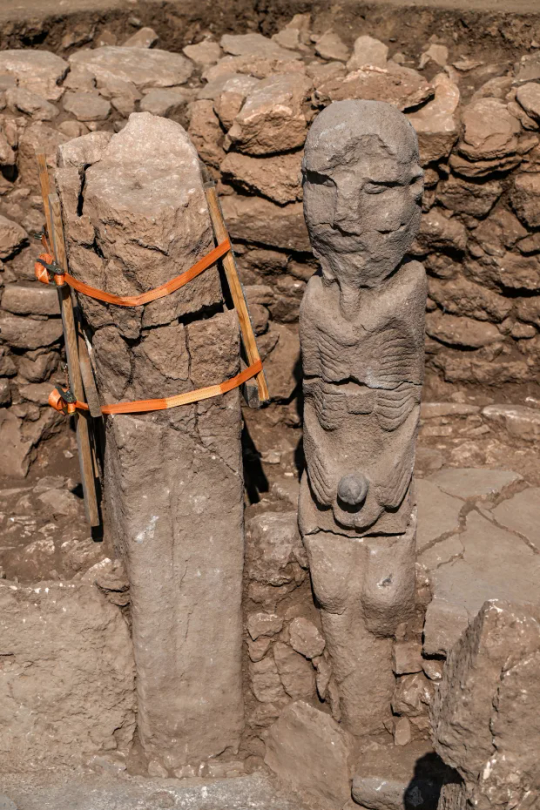


#Archaeologists Discover 11000-Year-Old Statue Clutching His Genitals in Turkey#Karahan Tepe#Gobekli Tepe#temple#ancient temple#ancient artifacts#archeology#archeolgst#history#history news#ancient history#ancient culture#ancient civilizations
76 notes
·
View notes
Text
Cosmic choreography fixed in stone! Hugh Newman journeys through time guiding us to megalithic marvels aligned to the winter solstice. Witness the rebirth of the sun and the ancient celebrations etched in enduring rock.
35 notes
·
View notes
Text
youtube
Karahan Tepe: The Mysteries of The Oldest Known Settlement
46 notes
·
View notes
Text
Thank you, miniminuteman, for informing me of the existence of
T H E P E N I S R O O M .
30 notes
·
View notes
Text
youtube
2 notes
·
View notes
Text
BREAKING: Major New Discoveries Unearthed at Karahan Tepe & Gobekli Tepe
Three incredible ancient artifacts have just emerged from the sands of time at two of Turkey’s greatest archaeological sites – Göbeklitepe and its sister site of Karahantepe.
Photo: The Ministry of Culture and Tourism
With both of these sites being dated between 11,000 and 12,000 years old, they are some of the oldest prehistoric sites on earth.
Photo: The Ministry of Culture and Tourism
As…

View On WordPress
6 notes
·
View notes
Text

Here’s my personal recommendation of a YouTube video to check out:
youtube
#archeaology#human history#Karahan tepe#tumblr recommendations#recommend#recommendation#youtube#youtube content#youtube recommendations#youtube video#video recommendation#youtube link#video link#youtube video recommendation#turkey#archaeological#history#educational youtube#educational videos#educational post#learning#learning videos#history YouTube#history videos#humanity#spreading awareness#turkiye#video essay#ancient history#world history
3 notes
·
View notes
Text
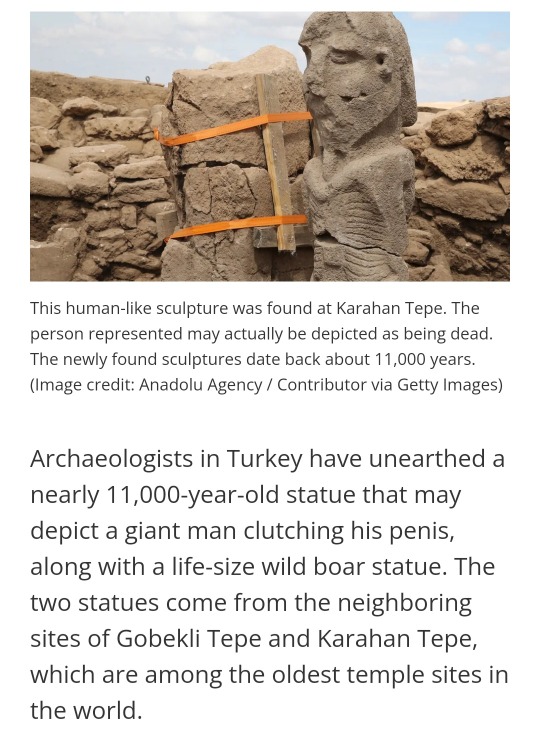

1) "May depict," my ass. That's the only part of it that was carved with an eye for realism.
2) People 11,000 years ago were at least honest enough to admit that religion is at least 70% about guys whipping their dicks out.
4 notes
·
View notes
Text
What with Göbekli Tepe and Karahan Tepe, Turkey seems to be the hub of an awful lot of extremely old religious activity. Really, it boggles the mind. And it's only NSFW if you take it out of its context.
14 notes
·
View notes
Text

from Karahan Tepe, approximately 11,000BC
35 notes
·
View notes
Link
Mind: Blown. (Though the author could’ve used an editor with a broader view of the world to point out stuff like, maybe include the name of the man who found the original site and don’t just call him “the shepherd”.)
But like:
Necmi shrugs. He does not know. One of the glories of the Tas Tepeler is that they are so old, no one knows. Your guess is literally as good as the expert’s. And yet a very good guess, right now, leads to the most remarkable answer of all, and it is this: archaeologists in southeastern Turkey are, at this moment, digging up a wild, grand, artistically coherent, implausibly strange, hitherto-unknown-to-us religious civilisation, which has been buried in Mesopotamia for ten thousand years. And it was all buried deliberately.
I should point out that even though the Spectator article was only just published this month, the scientific literature I glanced at seems to be at the very least disagreeing on “buried deliberately”, if not outright agreed on more natural explanations.
Monumental buildings at Göbekli Tepe were “buried” with enormous amounts of detritus material in ancient times. This deposit, commonly referred to as backfill, is composed of extensive amounts of fist-sized limestone rubble interspersed with archaeological artifacts, primarily lithics and animal bone. An intentional (ritually charged) burial of buildings was previously posited (36–38); more recently, however, other explanations appear increasingly likely, including inundation from building collapse and eroded deposits from higher-lying and adjacent parts of the mound.
- Gresky, J., Haelm, J., & Clare, L. (2017). Modified human crania from Göbekli Tepe provide evidence for a new form of Neolithic skull cult. Science advances, 3(6), e1700564. https://doi.org/10.1126/sciadv.1700564
8 notes
·
View notes
Text
Oh to be the head observing the penis room at Karahan Tepe
1 note
·
View note
Text
Dive deeper into the depths of Karahan Tepe's new archaeological treasures, where excavated remnants have just unveiled a captivating realm of ancient rituals, subterranean enclaves and perplexing carvings.
24 notes
·
View notes
Text
archaeology student and one of the women at the frat party be like damn this is just like that room in Karahan Tepe
1 note
·
View note
Text
@COASTTOCOASTAMOFFICIAL Hugh Newman delves into ancient wonders like Gobekli Tepe, unveiling hidden energies, sacred geometry, and rituals dating back 12,000 years. Learn about most recent finds at these megalithic sites, from symbolic designs to celestial connections, as Hugh Newman sheds light on their enigmatic purposes and fascinating histories.
To learn more about featured guest speakers on this show please visit https://www.coasttocoastam.com/show/2...
COAST TO COAST AM is Produced and Owned by Premiere Networks Inc/iHeartMedia
2023 All Rights Reserved
2 notes
·
View notes
Text
Archaeologists in Turkey have unearthed a nearly 11,000-year-old statue that may depict a giant man clutching his penis, along with a life-size wild boar statue. The two statues come from the neighboring sites of Gobekli Tepe and Karahan Tepe, which are among the oldest temple sites in the world.
The wild boar statue, which is carved from limestone, was found at Gobekli Tepe and dates to between 8700 B.C. and 8200 B.C. It measures 4.4 feet (1.4 meters) long and 2.3 feet (0.7 m) high, the German Archaeological Institute said in a statement.
Archaeologists detected red, black and white pigments on its surface, indicating that the sculpture was once painted.
Archaeologists unearthed the large sculpture of the man at the site of Karahan Tepe, about 22 miles (35 kilometers) from Gobekli Tepe. It depicts a 7.5-foot-tall (2.3 m) man, according to a translated statement from Turkey's ministry of culture and tourism. The person's ribs, spines and shoulders are particularly pronounced, and the person may actually be depicted as being dead
3 notes
·
View notes